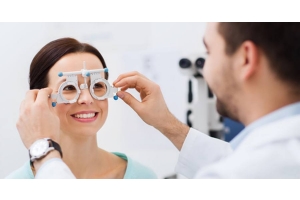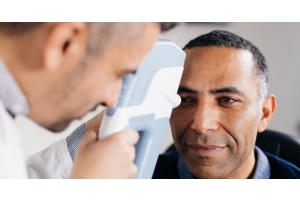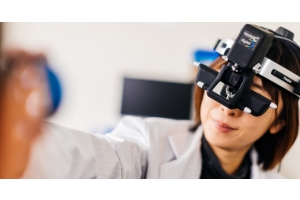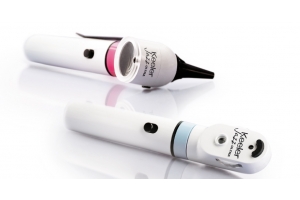
Corneal edema refers to the swelling of one or multiple layers of the cornea. Corneal swelling is a common condition that can affect anyone but is frequently seen in people over the age of 50. If there is significant swelling of the cornea, vision may become cloudy. Medical treatment or surgery is required in some cases to prevent or correct vision loss.
What Is the Cornea?
The cornea is the transparent, dome-shaped outer surface of the eye. It is the eye's outermost lens and focuses more than 50 percent of the light that enters the eye. The cornea itself consists of five different layers which are the:
Each of these structures is critical in helping your patients see clearly. But the endothelium is primarily responsible for providing vision transparency by removing fluids from the cornea.
Causes and Risk Factors of Corneal Edema
The primary cause of corneal edema is the buildup of fluid in the eye. One of the most common causes of excess fluid is Fuch’s Endothelial Dystrophy (FED). FED is an inherited disease resulting from dysfunction of the endothelial cells in the cornea that are responsible for draining fluid from the eye. It is commonly seen in patients that are the age 50 and older and women more than men. The following are risk factors of damage to these important cells leading to corneal swelling:
What Are the Symptoms of Corneal Edema?
Blurry or cloudy vision is typically the first sign of corneal swelling. It is more noticeable in the morning and tends to get better as the day progresses. Other possible symptoms include:
How Is Corneal Edema Treated?
As an eye care professional, it is your job to determine the most appropriate course of treatment for your patients depending on the root cause of the condition. Sometimes treating the underlying condition itself can resolve the swelling. According to the National Eye Institute (NEI), treatment options for corneal swelling resulting from Fuchs’ dystrophy include:
Medications may be prescribed to glaucoma patients to reduce eye pressure. Some doctors recommend using a hairdryer to blow air on the eyes. This helps reduce swelling by increasing the evaporation of tears. Laser surgery or corneal transplant may be recommended if the condition is severe enough.
Understanding the Types of Corneal Transplant
For the most part, mild cases of corneal edema may not need any treatment. In most instances, ophthalmologists recommend saline drops to provide relief. If the swelling becomes severe enough to cause vision issues, surgical procedures may be required. In general, the three types of corneal transplants are:
Full Thickness Corneal Transplant
A full-thickness corneal transplant —also called penetrating keratoplasty (PK)— is done to remove the damaged cornea or the tissue affected by Fuchs’ dystrophy and replace it with a clear cornea from a donor. PK has a longer recovery time compared to other types of corneal transplants. Vision may also take a longer time to return (up to a year) and the risk of corneal rejection is high.
Partial Thickness Corneal Transplant
A pPartial-thickness corneal transplant — also called deep anterior lamellar keratoplasty (DALK)— is another surgical option that involves removing the damaged front and middle layers of the cornea. These two layers are removed and the back layer (endothelial layer) is left intact. Recovery time following DALK is shorter compared to a full corneal transplant. There is also less chance of the body rejecting the new cornea.
Endothelial Keratoplasty
Endothelial keratoplasty (EK) is an advanced cornea transplant surgery that largely replaced penetrating keratoplasty (PK) in the treatment of Fuchs' endothelial dystrophy. The surgical procedure is done to replace the damaged endothelium of the cornea with healthy donor tissue. It is a partial transplant since only the innermost layer of the cornea (the endothelium) is replaced. The two common types of endothelial keratoplasty procedures are:
Descemet's Stripping (Automated) Endothelial Keratoplasty (DSAEK
DSAEK is the current standard surgical treatment for patients with significant vision problems due to corneal swelling caused by FED or pseudophakic bullous keratopathy (swelling of the corneal layer called the stroma). It is appropriate for patients who did not respond to medical therapy.
The partial corneal transplant surgery is done to replace the damaged or diseased endothelium. The Descemet’s membrane and endothelium are stripped. Healthy endothelium and DM, along with a small amount of stromal tissue are then transplanted from a corneal donor. Much of the cornea remains untouched during the procedure.
Questions? Contact Keeler today!
We have been manufacturing diagnostic ophthalmic equipment for eye care professionals for over 100 years in our vision to contribute to a world without vision loss. We have a large inventory of ultrasonic and diagnostic equipment as well as a pharmaceutical and PPE line. If you have any questions or would like more information, please call our toll free number at 1-800-523-5620 or email us at customerservice@keelerusa.com. We offer a vast range of different ophthalmic and optometry supplies and equipment, including:
We regularly partner with different high-tech ophthalmic solution providers, general medical instrument manufacturers, veterinary diagnostic specialists, and more to provide specialized OEM manufacturing.









